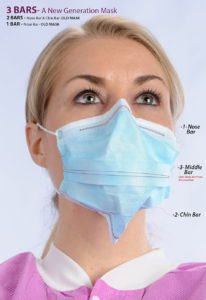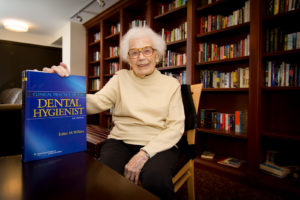IS THERE AN ASPECT of American life more tumultuous, day to day, than health care? Its very importance, of course, is what makes it so contentious: Politically, socially, technologically, financially and medically, the topic is unavoidable.
Dentistry, too, is close to omnipresent. There’s the continuous struggle to ensure that the medicine we practice is covered by insurers. The battles waged and time volunteered in an attempt to deliver care to underserved communities in hidden corners. The heroic effort made, at every level of our profession, to help people understand that oral health is the gateway to whole-body health—and then act accordingly.
All those factors help explain why every spring’s revelation of the year’s Edison Awards nominees blows in like a cool, cleansing April breeze. If dentistry is to continue to make great strides, as surely it will, we’ll thank those dedicated strivers who engage in the sort of trial and error that, now and again, brings a groundbreaking new product or treatment to market.
What you’ll find in the pages that follow are the most promising and intriguing dental innovations for 2019. They stem from constant experimentation by bright people inspired by the man whose name graces these awards—and by helping make dentistry’s tomorrows even more promising than today, they’ll play no small role in ensuring that health care, while forever fraught, will never fail to move forward. The future begins here. What will it usher forth?
About the Edison Awards
SINCE 1987, the Edison Awards have recognized and honored some of the most innovative new products, services and business leaders in the world. The Awards are named for Thomas Alva Edison (1847-1931), whose extraordinary new product- and market-development methods garnered him 1,093 patents and made him a household name around the world. The Edison Awards symbolize the persistence and excellence personified by Edison himself, while also strengthening the human drive for innovation, creativity and ingenuity.
ARCHAWAY 3 BARS FACE MASK
ValuMax International
Inventor: Jane Jia, 50
THE DAYS OF USING surgical masks that caused one’s vision to blur, gaped at the cheeks and collapsed in the middle of the mouth are officially over. For that, dentists can thank the New York–based protective-apparel company Valumax International and its ArchAway 3 Bars Face Mask.
The logic behind it is unassailable: Only a face mask with three bars (or more) can fit the three-dimensional human face properly. Unfortunately, this simple fact took a long time to catch on—and in the meantime, insufficient one- and two-bar masks have dominated the market. Valumax’s mask sports a breathable design, with fibers that remain mostly immobile to promote airflow, and a plastic wire across the middle to keep it away from the mouth and nose.
The inside is silk-lined to prevent skin irritation, and its filtration rate is more than 99 percent. Its fluid strength is superb, withstanding all manner of errant splashes in the operatory. “It makes a lot of old mask constrictions go away,” says Jane Jia, its lead inventor. “You can’t tell much difference between a regular procedure mask, a surgical mask and a laser mask anymore. It’s overall cooler, less foggy and fits better.”
Valumax has been met with acclaim at trade shows; already more than 2,000 dental practices and companies have switched
to its revolutionary design. “It’ll give people new vision for mask design,” Jia says. And better, fog-free vision overall.
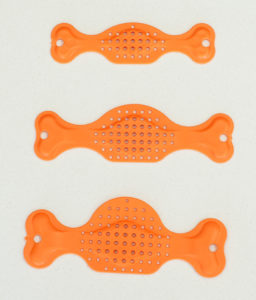
Zirc Dental Products
Inventors: Drs. Gargi Mukherji and Ralph Cooley
WORRIED ABOUT USING gauze packs to protect patients’ airway during procedures? We don’t blame you. They’ve been known to pose a threat to patient and practitioner alike if they become lodged in the throat, and another popular alternative, the dental dam, can be intimidating. Zirc’s Airway Armor, however, eliminates the risk of burs, files, implants, veneers and even orthodontic brackets from being inadvertently swallowed, making it an ideal option for procedures involving extractions, implants and orthodontics.
“There are so many procedures in which an accident can happen,” says Dr. Gargi Mukherji, Airway Armor’s co-inventor. “A loose crown can slip out of your hand, or the patient can move. If it goes down the esophagus, the patient may eventually pass it, but if it goes into the airway, it can be really bad. It’s in the literature that patients have died.”
Morbid tales in mind, Dr. Mukherji and his compatriot Dr. Ralph Cooley got busy designing a single-use, perforated plastic device with holes on each end that a dentist can thread with floss for easy insertion and removal. It protects the throat while helping keep the patient’s mouth open and allows for comfortable breathing.
Airway Armor comes in packs of 15, in three sizes. It was a natural for Zirc, given its existing line of easy-to-use isolation products. It’s all about protection, after all: the health of the patient and the liability of the doctor.
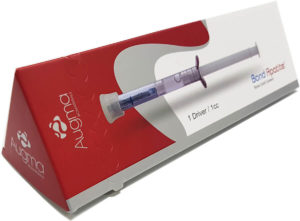
Augma Biomaterials USA
Inventor: Amos Yahav, 59
JUST AS concrete changed construction and bone cements changed orthopedics, Amos Yahav, CEO of Augma Biomaterials, understood the need for good bone cement to help change dentistry. He ended up devising Bond Apatite, a revolutionary composite bone-graft cement intended to restore and rebuild maxillofacial bone defects and deficiencies by regenerating patients’ own bone in a minimally intrusive manner that allows for faster healing. The moldable cement is injected and hardens in situ—all in less than a minute instead of 10 to 20 minutes, as with conventional bone grafting.
“Before Bond Apatite, there were no suitable bone cements in the market for the dental field,” Yahav says. Available products have long comprised other grafts in the form of granules, blocks and putties, with drawbacks including membrane coverage and cumbersome application. Bond Apatite, by contrast, requires “less skillfulness,” according to Yahav. “Surgical time is significantly shortened and pain is reduced to almost zero.”
Development took 15 years. “The investment was self-funded, and no one at the time believed in my vision,” he adds. “I invested all my savings and mortgaged my house—but nowadays, when thousands of clinicians around the world are using it, I realize it was well worth it. Changing augmentation is thinking completely in a different direction—in a way that improves the patient’s and clinician’s experience.”
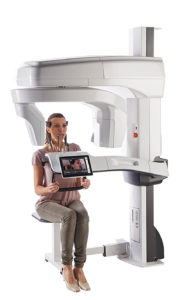
Carestream Dental
Inventor: Stephane Varlet, Product Line Manager, 48
OBTAINING CLEAN CBCT imaging is a frequent challenge, whether because of difficulties with correct and consistent patient positioning, capturing accurate scans on the first try, or both. Carestream’s new CS 9600 builds on the technology the company introduced with its CS 8100 3D (its best seller) to address dentists’ unmet needs.
The platform introduces humanized smart technology, such as a face scanner that provides realistic three-dimensional facials and automatically superimposes the surface scan with CBCT images and 3D models, a live positioning assistant via video camera and embedded cameras to monitor the patient throughout.
A dentist can even repeat a procedure with a single touch. “The CS 9600 is the first unit that records the parameters for each patient exam and proposes to recall them for the patient’s next exam, all with the touch of a button,” says Stephane Varlet, Carestream’s product line manager. Additionally, a high-resolution intuitive SmartPad makes the entire experience easy and fast, giving a dentist the chance to review images quickly after each scan.
CS 9600 comes in three versions: 12×10, 16×10 and 16×17, with a flexible design that dentists can configure and expand as they grow into new areas. “The practice can easily upgrade to a larger field of view without replacing the unit itself, or [a dentist] can enable new functionality without fastidious unit upgrades,” Varlet adds. “We’re at the beginning of commercialization, but already 200 units have been ordered in less than a quarter.”
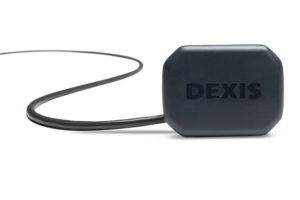
KAVO KERR
IT’S A COMMON TROPE that dentistry has lagged adopting new technologies that quickly find a home in other industries. KaVo Kerr’s newest intraoral digital X-ray sensor, DEXIS Titanium, puts the lie to that. The device follows the DEXIS Platinum, the market leader in intraoral sensors, and retains some of its predecessor’s award-winning features while fine-tuning its TrueComfort design with rounded edges. The new CleanCapture sensor also enhances image quality with improved tissue contrast.
Perhaps its most remarkable feature, though, is its Gesture Technology, which makes it the first such device to improve workflow efficiency with a motion-activated feature enabling dentists to capture X-rays without touching their computer. It’s likewise compatible with the add-on module DEXvoice for vocal activation. “You no longer need to de-glove, walk away or turn your back to the patient,” says Insiyah Ahmedi, KaVo Kerr’s marketing manager. “You can stay with your patient and use the voice- or motion-activated commands. It’s a completely new workflow for the dental office.” The device’s USB LED lights will indicate whether a connection is successful, and to protect patients from excess radiation it’ll shut off automatically if there’s a problem.
DEXIS Titanium was designed with a focus on durability. The sensor is engineered to withstand impact, and its housing has improved tensile strength. Demand appears to be there: In its first three and a half months on the market, more than 1,250 DEXIS Titanium sensors were sold across the U.S. and Canada.
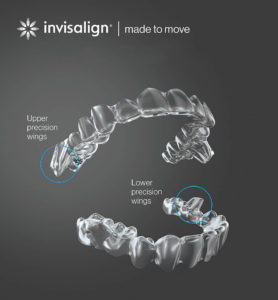
ALIGN TECHNOLOGY
ALIGN HAS MADE ITS name as the company responsible for more than 5 million new smiles via its popular clear Invisalign aligners. It also recently released this, the first clear-aligner solution for Class II malocclusion correction in teenagers, which combine the benefits of Invisalign’s original product with new features that help move the lower jaw forward while simultaneously straightening the teeth.
Malocclusion is common in teens, and Invisalign with Mandibular Advancement treats it with “precision wings” between the premolars and first molars that are made of the same SmartTrack material as the original aligners. The first phase corrects deep-bite and cross-bite problems and begins to tackle leveling; the second engages the precision wings as the patient bites down, correcting mandibular advancement in 2-millimeter increments by default.
The third, last phase entails final leveling and alignment, plus fine-tuning of the occlusion. The result: mandible correction that’s accomplished in less time, with more efficiency and greater comfort for the patient, who is often an anxious adolescent. A choice between this and brackets-and-elastics is, really, no difficult call at all.
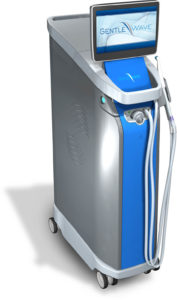
SONENDO
NO ONE LIKES a root canal, but in the U.S. the procedure saves an estimated 24 million teeth every year. The rotary files used to remove infected dentin sometimes remove more dentin than necessary, of course, and bacteria and tissue can be left behind. Sonendo’s new GentleWave procedure tackles those limitations with deep cleaning that also preserves tooth structure and dentin.
The technology involves what Sonendo calls SoundFlow, SoundBar and SoundResults, which entail fluid optimization using sodium hypochloride (NaOCI), EDTA and distilled water, which are delivered to the canal. Degassing ensures optimal fluid and energy distribution to break down bacteria and tissue—maximum penetration into areas that files typically can’t reach. And a cleaner canal means faster healing.
GentleWave removes more than 97 percent of tissue debris, a substantial improvement on rotary files and irrigation. It’s intended to treat molars, premolars, incisors and canines. “The entire organization is working collaboratively toward a common goal: to help endodontists save more teeth for more patients,” says Robert Guyatt, vice president of marketing at Sonendo. “As a result, nearly 500 U.S. endodontists and counting have adopted the GentleWave procedure.”
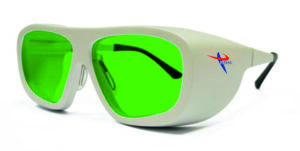
PIERREL PHARMA
Inventors: Scientists at the Università Cattolica di Roma, Rome, Italy
ORAL CANCERS of all kinds are the sixth most commonly occurring cancer worldwide, but survival rates are generally high if they’re caught early. Dentists are therefore uniquely placed to introduce early screening that’s proven to save lives.
Pierrel’s cutely named, rad-looking Goccles—oral-cancer screening spectacles; the name is actually an acronym for “Glasses for Oral Cancer Curing Light Exposed Screening”—make it easier to distinguish between healthy tissue and areas of concern. A special optical filter in the lens works with any curing light to detect suspicious precancerous dysplastic or anaplastic lesions by rendering them very dark against a green background. Goccles’ role, according to the National Institutes of Health in its summary review, “is that of a complementary inspection following naked-eye examination when dealing with patients at risk for oral cancer. The device allows detection of otherwise invisible lesions and otherwise impossible complete resections.”
Your patients will certainly appreciate the added care and technological value. The simple, non-invasive Goccles are a onetime purchase with no hidden costs; their only accessory is the curing light you already own. (A low-cost companion curing light is available separately.) The kit comes with accessories and complete instructions—as well as the satisfaction engendered by helping people detect early that which might otherwise do them great harm.
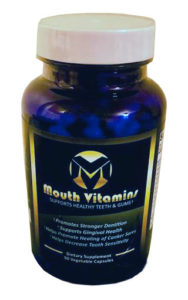
Mouth Vitamins
Inventor: Dr. Gurpreet Khurana, 38
STORE SHELVES GROAN with vitamins tailored to every need: for stronger hair, skin and nails; for optimal gut health. (So many bacterial cultures!) Oral health was therefore naturally next up. Dr. Gurpreet Khurana, a member of the Incisal Edge 40 Under 40 last year, saw a limited array of products that addressed specific dental concerns through vitamin therapy, so he created Mouth Vitamins to focus on fostering stronger dentition and gingival health while also reducing gum sensitivity.
“The process of developing a dietary supplement required considerable understanding of the mechanism and desired effects in relieving sensitivity, ulcers and bleeding gums,” says Dr. Khurana, who practices in Bellevue, Washington, just east of Seattle. “It was essential to deliver a product that defined the most common problems that patients experience.”
The vitamins, made in the U.S., are vegetarian, easily swallowed capsules containing Lysine, Coenzyme Q-10, B vitamins and more, which have been proven to decrease tooth sensitivity, heal canker sores and strengthen gums. Dr. Khurana’s goal is to get them increasingly recommended chairside, but for the moment they’re available only through his office. “Successful oral health is delivered through prevention,” he says. “Supplements that promote healthy teeth and gums aid in preventing dental disease and pain. Mouth Vitamins bring quality ingredients to assist with ailments most patients see when they lack certain vitamins in their diet.”

DENTSPLY SIRONA
COMFORT AND SAFETY go hand-in-latex-glove with efficient dentistry, especially when a doctor has an array of tools available to make procedures quick and seamless. With this in mind, Dentsply Sirona engineered Purevac, an HVE system kit that is putatively the first saliva ejector to combine high-volume evacuation of aerosols, fluid and debris from the mouth with tools such as a built-in dental mirror with a 360-degree swivel.
The animating idea: that the operatory team gets more done with a single piece of equipment, and blood-contaminated fumes and assorted splatter are minimized. (Studies show that aerosols can travel up to eight feet, and bacteria levels in the air are five times greater during a procedure.)
Purevac, by contrast, reduced aerosol prevalence 90 percent more than standard low-volume saliva ejectors in research studies. “This product helps create an environment with fewer potentially harmful aerosols, which benefits both patients and staff,” says Cameron Vague, product manager for preventative business at Dentsply Sirona.
Its ergonomics are sound, too. It boasts smooth rounded edges, and its kink-resistant hose is 69 percent lighter and 135 percent more flexible than standard HVE hoses. “It was conceived with preventive procedures in mind,” Vague adds, “and it’s ideal for procedures that generate significant liquids and debris.”
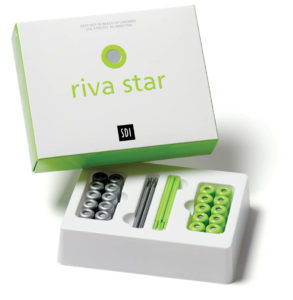
SDI North America
Inventors: Dr. Geoffrey Knight, Dr. Graham Craig, Hein Ngo
INNUMERABLE SILVER diamine fluoride products help relieve tooth sensitivity, but their unsightly outcome is occasional tooth staining when they come in contact with demineralized areas. Last year, though, Australian dental-manufacturing company SDI patented Riva Star, which contains SDF plus potassium iodide to reduce staining while relieving sensitivity almost immediately.
The combination of ingredients forms a silver iodide precipitate that doesn’t stain to the extent other SDF treatments do. It also has antibacterial properties, making it an effective biofilm inhibitor.
In several Latin American countries, SDI has registered Riva Star as an anti-caries agent; in Australia, Europe and the U.S., it’s registered as a desensitizing agent. “This product has the ability to reduce sensitivity to patients waiting on general-anesthetics lists within nursing and special-needs homes, where dexterity and ability to visit a dentist is reduced, as well as any other patient suffering from dental sensitivity,” says Joanna Greenham, global marketing manager for SDI. “It’s a very cost-effective solution to a problem so many face, especially with sugar consumption on the rise.”
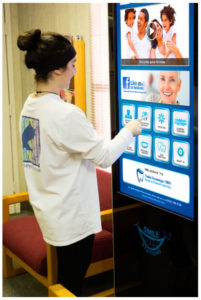
Smile Stations
Inventor: Nazar Kamanga, 49
THE DAYS OF patients sitting idly in a dreary waiting room, staring blankly at TV monitors playing videos on loop, are over—as is relying on dusty pamphlets to deliver educational resources to the drowsy crowd. Smile Stations, developed over four years by Nazar Kamanga, is the first interactive education and content-distribution platform that fosters digital patient engagement and supports communication and merchandising—all in your reception area.
It looks a bit like an immense iPhone mounted on the wall, and through its 32-inch touch screen, patients can learn about your practice’s promotions, new products and services and financing options. They can even write reviews while they wait. “It also provides ways for dental practices to initiate, support and close sales at the point of care,” Kamanga says. A newly integrated camera with filters and frames promotes easy social-media engagement.
Naturally, an educational component was paramount for Kamanga. “Dentists struggle to run a practice while educating patients about oral care, procedures and preventative medicine,” she says. “Likewise, dental brands have found it difficult to introduce professionally prescribed products to consumers in dental offices. That’s where Smile Stations come in.” •
DENTAL INNOVATORS HALL OF FAME
THE TOP THINKERS in dentistry or any other profession are those whose discoveries, inventions and great works stand the test of time. Whether through product development, service to others, sheer historical import or some combination of the three, those in our Hall of Fame greatly exceed the standard—and we’re proud to welcome a new inductee into this august club for 2019.
2019 INDUCTEE
ESTHER WILKINS
Author of Clinical Practice of the Dental Hygienist, an industry bible first published in 1959 now in its eleventh edition. Dr. Wilkins won the Lucy
Hobbs Industry Icon Award from Benco Dental and Incisal Edge in 2015. One of just three women admitted to the Tufts University School of Dental Medicine’s class of 1949, she later became the namesake of the indispensable dental instrument the Wilkins/Tufts Explorer. Lauded by the American Dental Association as “a shining star in dental and allied education,” Wilkins passed away December 12, 2016, three days after her 100th birthday.
2018
FRANCIS MOUYEN
This French inventor developed the first digital imaging system specifically for dentists, debuting it in Switzerland in 1987. He also invented a dental chair with a computer monitor, his digital sensor and an intraoral camera built in. His non-dental inventions include an electric-motor propulsion system for boats and underwater monitors used by researchers studying marine mammals.
2017
RAFAEL BOWEN
Invented the first truly effective resin-based dental composite, which he introduced in the 1960; he also played a major role in the development of sealants.
DAVID SCHICK
Inventor of the Schick Sensor, the first technology that enabled dentists to create and view large, clear intraoral images while exposing patients to less than a tenth of the radiation they’d receive via a standard X-ray.
2016
RICHARD M. PELTON AND ERNEST CRANE
Pelton and Crane’s eponymous industry giant got its start as an modest two-man operation back in 1900. Now, nearly 120 years later, their names remain a byword for dental quality.
GORDON J. CHRISTENSEN
An educational giant, Dr. Christensen founded Practical Clinical Courses, a continuing-education company for dental students worldwide. He and his wife, Dr. Rella Christensen, founded the influential news-letter Clinicians Report in 1976.
2015
ROBERT MEYER
President of the DentalEZ Group and a pioneer in the development of 100 percent water-free vacuum devices, dental separation tanks and much more.
LUCY HOBBS
The first American woman to earn a dental degree when she did so in 1866, Dr. Hobbs is the inspiration for Benco Dental’s Lucy Hobbs Project, which celebrates and promotes women in dentistry worldwide.
2014
JACK DILLENBERG
The inaugural dean of the Arizona School of Dentistry & Oral Health at A.T. Still University in Mesa and a passionate longtime advocate for a community-based dental curriculum.
HOWARD FARRAN
Phoenix-based dentist and MBA; founder and publisher of Dentaltown magazine and Dentaltown.com. A self-proclaimed “physician of the mouth” and proponent of dentistry as a vital component of whole-body health.
2013
WILLIAM B. DRAGAN
Founded Centrix in 1970. He developed products including the Mark I, II and III syringes, composite-resin tubes and plugs, and more.
JOHN V. BORDEN
Enlisted in the Navy as a dental surgeon and served in both the Atlantic and Pacific theaters during World War II. The inventor of the Borden Air-Rotor, he passed away in 2011 at age 95.
2012
JOSHUA FRIEDMAN
Founder and CEO of dental-product manger AdDent, founder of Demetron Research Corporation and a pioneer in the evolution of light-curing technology.
JIM GLIDEWELL
Founded Glidewell Dental Laboratories in 1970. The company led the industry in developing crowns and bridges, ceramics, removable full and partial dentures, dental implants and more.


